Introduction
In 1970, the Organization of American States suggested that it was necessary to study the volume of articles published in journals inside and outside the region to evaluate and promote Latin American scientific journals. This is not only useful for assessing and measuring the magnitude of regional scientific effort, but also for formulating, designing and implementing national and international policies to foster and promote scientific development and production. 1
Similarly, in recent years, research has gained importance and has become the prelude to scientific production, impacting the academic, scientific, economic and social development of the countries in which the research is carried out. 2 This last aspect brings with it the need for quantification and evaluation of scientific activity, its achievements and impacts.
Scopus is a database, shared with Science Citation Index (SCI), of great global relevance for citations and abstracts of peer-reviewed literature: scientific journals, books and conference proceedings. It has intelligent tools to search, analyze and visualize research works, giving an overview of scientific production around the world on science, technology, medicine, social sciences, arts and humanities.
It is important that researchers and editors of scientific journals become familiar with this database, and that academic institutions promote publication in journals indexed in Scopus 3, in order to make their academic productions visible worldwide. Therefore, the publication of articles in indexed journals is key for the evaluation of scientific production and, consequently, as an element of global scientific evaluation.
One of the many responsibilities that medical professionals, students and health personnel have is publishing the research they carry out during their training. 4-6 Only by publishing it is possible to know the impact factor, which is used to measure the number of articles published and the number of times these publications have been cited in other publications. 4 So, in this context, the question arises: why investigate?
In response to this question, research is fundamental in the training of individuals who wish to know more and be more creative, critical, persevering and passionate about solving problems and being part of the solution. 6 Thus, in a study addressing student scientific production in Latin America, the countries that had the most journals with student publications were Colombia, Chile and Peru 7, despite the fact that student contribution was not significant due to the large number of students. Based on these publications, students develop their first research tools and then consolidate themselves in the scientific production of their country and even their continent. They also contribute to the generation of knowledge, intelligent decisionmaking based on sound scientific results and beneficial changes of social impact.
The term "scientific production" refers to the number of publications containing results of scientific research from authors, institutions, regions and countries on different areas; these data are included in nationally and internationally recognized bibliographic indexes. 8,9
In this context, this work aims to evaluate the level of scientific production in Medicine in South America using the Scopus database, in order to identify and compare the characteristics, variations, position and trends between countries and economic blocs (Mercosur and the Andean Community). To this end, information on scientific production of the main South American countries during the period 1996-2016 was considered.
In short, this study seeks to provide approximate data useful for a reflection on scientific production in the region and its analysis in future situations in time and space, in order to create beneficial strategies or activities in favor of scientific production in each country and as a region.
Materials and methods
This was a bibliometric, observational, descriptive and cross-sectional study based on records from publications indexed in the Scopus database in South America from 1996 to 2016. To this end, an analysis of scientific production and a comparison between countries and economic blocs was performed. Scopus data was obtained from Scimago Journal & Country Rank (SJR), a tool developed by the SCImago Research Group that offers scientific indicators of journals and countries from Scopus.
The main tools used for systematization, calculations on growth rates, participation structure and the elaboration of tables and output figures were the Scopus database and Microsoft Excel 2010.
All the countries in South America were considered as study variables: Argentina, Bolivia, Brazil, Chile, Colombia, Ecuador, Paraguay, Peru, Uruguay and Venezuela. Additionally, overall production, average annual production, average growth rate per year and share of scientific production per country were taken into account.
Limitations
Regarding limitations, this work only evaluated scientific production in South America published in Scopus, considering that there are countries with scientific publications that are not included in this database. Therefore, it is expected that new studies look for similar results in other national and international indexes.
Although this study does not evaluate the quality of the published works and their analysis in each country, this factor should be considered in future studies in order to know their relationship.
Furthermore, several factors involved (political, academic, social) and other actions that promote research and publication in these countries and that may be reflected in scientific production should be considered.
Results
Table 1 shows that the accumulated production of research in Medicine in South America during the period 1996-2016 was 327 975 publications. Brazil stands out with 210 969 publications, followed, in order of relevance, by Argentina (44 826), Chile (27 716) and Colombia (19 753). The remaining countries have less than 10 000 publications, being Bolivia and Paraguay the countries with the lowest amount of publications with only 1 173 and 784, respectively.
Table 1 Overall production, annual average, growth rate and participation in research in South America per country. 1996-2016.
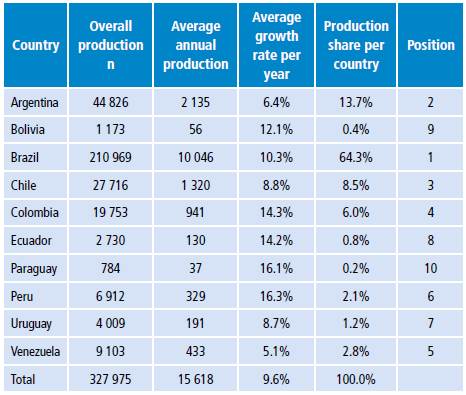
Source: Own elaboration.
With respect to average research production per year, South America has 15 618 publications; Brazil also stands out with 10 046 research works and Argentina with 2 135; the other countries have less than 1 500 publications, with the lowest number in Bolivia with 56 and Paraguay with 37.
However, the countries with less than 1 500 publications have a significant average annual growth, as in the cases of Peru (16.3%), Paraguay (16.1%), Colombia (14.3%), Ecuador (14.1%) and Bolivia (12.1%).
Considering growth levels in these countries, an upward trend in scientific production is expected in the coming years, provided that the entities linked to the promotion of research pay the necessary attention and provide support, particularly in Paraguay and Bolivia, which show the lowest levels of scientific production. The rest of the countries have an average annual percentage variation below 10.0%, the lowest being Venezuela with 5.1%.
Regarding the structure of participation in scientific production per country, Brazil stands out again with a contribution of 64.3% of the total number of South America, followed by Argentina with 13.7%; whie the other countries' share is below 10.0%. In other words, Brazil and Argentina contribute with 78.0% of the publications produced in the region, while the remaining 22.0% corresponds to other countries, of which Ecuador (0.8%), Bolivia (0.4%) and Paraguay (0.2%) have the lowest levels of contribution.
Figure 1 shows the trend in the levels of scientific production achieved by Bolivia, Paraguay, Ecuador, Uruguay and Peru, in which Peru stands out with an upward trend since 2002. In addition to this, Uruguay has had a growing trend since 2002 and Ecuador since the beginning of 2005, although a slight decrease is observed in 2007 before recovering its growth level. In the cases of Bolivia and Paraguay, there was a relatively static trend until 2005, but after 2006, they showed a slight recovery; as far as Bolivia is concerned, their level of growth is lower than that of Paraguay.
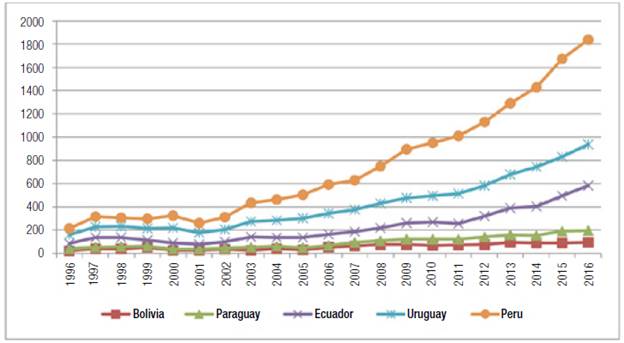
Source: Own elaboration
Figure 1 Comparison of the level of scientific production in Bolivia, Paraguay, Ecuador, Uruguay and Peru. 1996-2016.
Figure 2 shows the trend in the volume of scientific production of Bolivia, Colombia, Venezuela, Chile, Argentina and Brazil, in which the latter stands out with a highly significant level compared to the rest of the countries, being more visible since 2002. Although Argentina and Chile have a slightly increasing trend, it is not as evident as the one of Brazil, which shows a vertiginous growth.
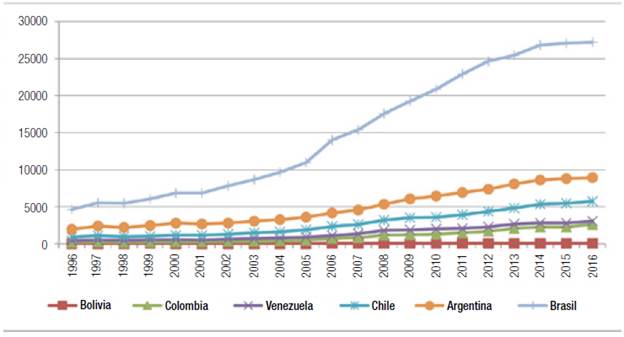
Source: Own elaboration
Figure 2 Comparison of the level of scientific production in Bolivia, Colombia, Venezuela, Chile, Argentina and Brazil. 1996-2016.
The economic bloc of the Southern Common Market (Mercosur), which includes Argentina, Brazil, Paraguay, Uruguay, Venezuela and Bolivia, has a scientific production with a volume of 270 864 publications, which represents 82.6% of the overall amount of South America (327 975) (Table 2). Within this bloc, Brazil stands out with 77.9% of participation, followed by Argentina with 16.5%; both represent 94.4% of the total of Mercosur and the remaining countries reach together 5.6%. This situation is evident when understanding that these two countries show a higher degree of economic and social development than the other members of the group.
Table 2 Overall production, annual average, growth rate and participation in research work in member states of Mercosur. 1996-2016.
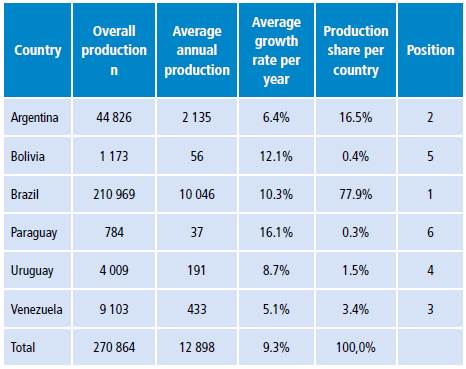
Source: Own elaboration.
On the other hand, the average scientific production per year in the member states of Mercosur was 12 898 publications, of which Brazil contributed with an average production of 10 046 works per year; the lowest figures correspond to Bolivia and Paraguay. However, taking into account the average growth rates per year by country, Paraguay (16.1%), Bolivia (12.1%) and Brazil (10.3%) stand out.
By analyzing the importance of scientific production within the framework of the Mercosur economic bloc, a positive and growing trend is observed in the 2002-2015 period, excluding 2016 as it presents a slight decrease in the volume of production.
Brazil is the main contributor to the growing trend of scientific production, with the highest proportion of research carried out within the framework of Mercosur; Argentina ranks second with a relatively significant contribution as well.
Table 3 depicts the scientific production within the framework of the Andean Community of Nations (CAN), which comprises the countries of Bolivia, Colombia, Ecuador and Peru, with a production volume of 30 568 works that, compared to the level of production of all South American countries, represents 9.32% and a 11.3% participation in relation to Mercosur (270 864 publications). In both the scientific contribution of members of the CAN is very low.
Colombia stands out among the CAN memberss with a total accumulated production in the study period of 19 753 papers, which represents a contribution of 64.6%, followed by Peru with 6 912 scientific papers, with a participation of 22.6%. The other member countries have less than 3 000 publications, with Bolivia being the lowest contributor with only 1 173 papers and a contribution below 10.0%.
Table 3 Overall production, annual average, growth rate and participation of research works according to member countries of the Andean Community of Nations. 1996-2016.
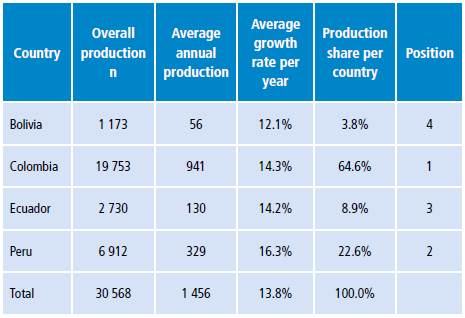
Source: Own elaboration.
As for the average growth rate of scientific production per year, the CAN countries show a significant increase of 13.8%, as opposed to the growth level of Mercosur, which is 9.3%. Although the member countries of the CAN present marked differences in their contribution to scientific production in Medicine, the levels of growth per country are quite significant, since they exceed their growth rate by more than 12%. This means that there is a significant increase in the levels of research, which, if maintained, would imply a recovery and contribution in the field of research, not only as members of the CAN but also of other economic blocs or integration agreements, as well as in South America.
With regard to the trend of scientific production in all the CAN member countries, a significant upturn since 2002 onwards is observed. In this context, the countries with the highest contribution to the growth of scientific production levels are mainly Colombia and Peru, although Ecuador is equally important with a significant contribution since 2009; however, in the case of Bolivia, its participation is imperceptible.
Discussion
Considering the results obtained, Aguado-López & Becerril-García 10 report a sudden fall in scientific production in Venezuela, represented by the Ibero-American scientific production of 2005, which went from 5.5% to 3% in 2014. This coincides with this work, where participation was 2.8% and the average annual growth rate was negative for South America.
In the case of Peru, the study by Arroyo-Hernández et al.11, a bibliometric analysis of biomedical scientific production in the Ica region between 1998 and 2010, showed important evidence of student participation in the publication of scientific articles. These approaches add to Huamaní et al.12, who described a 4.5% student participation in Peruvian medical journals indexed in SciELO-Peru between 1997 and 2005. This reflects the participation of undergraduate students in scientific publications in indexed journals. 13,14
On the other hand, Eróstegui-Revilla et al.15 state that Latin America contributes with 4% of the scientific production worldwide, and that Brazil ranks first with a contribution of more than 50% of said value, data that coincide with this work. Bolivia's contribution represents 0.3% of Latin America scientific production and 0.01% worldwide. Considering that there are scientific journals in this country that are not indexed and others that do not have ISSN, much of its scientific production is not visible and therefore not quantified.
Likewise, according to a study addressing scientific production in PubMed database from 1999 to 2008 16, the country with the largest scientific contribution in Ibero-America was Brazil, with more than 50% of the scientific production in health areas, followed by Mexico and Argentina, considered as large producers. Next were Chile, Colombia, Venezuela, Cuba, Puerto Rico and Uruguay with a contribution between 1% and 6%; these countries make up the group of medium-sized producers. Of a total of 20 countries studied, the remaining 11 (Peru, Costa Rica, Ecuador, Panama, Guatemala, Bolivia, Paraguay, Nicaragua, Honduras, Dominican Republic and El Salvador) were considered small producers for their contribution was <1% 16, a situation that reflects similar results in the present study.
Mayta Tristán et al.17 report that 60.8% of the medical students surveyed in their study say that there are limitations for publishing at undergraduate level due to lack of teaching support and academic incentives. Considering that university training in research is perceived as deficient by undergraduate students in Latin America, 90% of these students did not consider the quality of their study as a limiting factor. 17 In this way, universities and other academic institutions linked to research should encourage and strengthen scientific production in students, in order to recover the culture of critical reading and writing. This should be done with students, teachers, university authorities and all those involved in this profession.
In Chile, ranked fourth in SCImago and with the highest number of scientific publications in the Latin American region, the participation of medical students in scientific production is relevant 18, which probably causes a positive effect that is reflected in its 8.5% contribution so Latin American scientific production, after Brazil and Argentina.
As for Colombia, the role of public universities in the scientific production indexed in Scopus in the area of medicine is notable, considering that 75.7% of its production comes from 6 public universities, whereas 69.9% of indexed scientific production comes from the same institutions. 19 This would weigh the country's position in South America, considering that, according to the data reported here, Colombia has an outstanding participation (64.6%) in comparison with the other CAN member countries. Regarding research policies in this country, it was found that "research incubators" are considered as a strategy of extracurricular pedagogical training and aim to promote research in undergraduate students 20,21; they also have a positive impact in terms of scientific participation, based on the results reflected in this study.
Conclusions
In South America, the scientific production shares of Brazil, Argentina, Chile and Colombia are highly relevant, since together they contribute with more than 90% of the overall production in Latn America. In addition, there is evidence of the existence of countries with low levels of scientific production; however, they have significant average growth rates per year, so their scientific contribution is expected to increase significantly in the coming years.
It is necessary to create scientific research networks in South America and the economic blocs by identifying and bringing together academic instances, collegial groups and scientific associations of undergraduate students, in order to promote and support those countries whose volumes of scientific production are currently low.
Strategic alliances of research groups should be established in each country and between countries with less developed scientific production activities in the field of Medicine. 22
It is recommended that medical schools in countries with low levels of scientific production inplement in their curricula subjects such as research methodology, statistics, research ethics, scientific writing and publication or related policies to deepen and achieve greater knowledge regarding the use of tools that are necessary to keep a constant line of research. They should also promote, as a university policy that allows their production to be reflected, the indexation of their journals and publications in databases that are recognized worldwide. Student collaboration is essential to promote research, for it is a way to make possible the continuous training of researchers.














